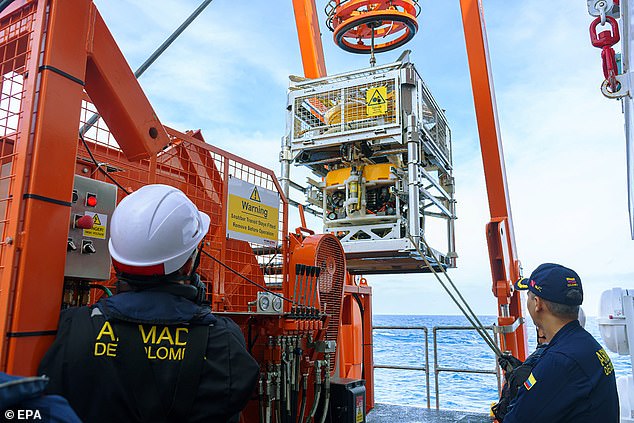The “holy grail” of shipwrecks remains at the bottom of the ocean filled with billions of gold and jewels, but the Colombian government has claimed it for itself.
The legendary galleon San José, which sank off the Caribbean coast of Colombia more than three centuries ago, is believed to contain $20 billion in gold, silver and emeralds.
Colombia declared the site a “protected archaeological area” and has now launched an underwater expedition to evaluate “the long-term preservation and the development of research, conservation and valuation activities” necessary to secure the historic find.
The first stage of this process will focus on obtaining images of the ship through “non-intrusive” remote sensors, according to the Colombian Institute of Anthropology and History.
The institute added that the results of this research mission could pave the way for future explorations, which could recover archaeological materials from the wreck.
The equipment used to search for the remains of the San José galleon submerged almost 3,100 feet under the Colombian Caribbean Sea. It was operated by naval officers.
Institute researchers explained that they intend to deploy an underwater vessel equipped with sonar-like acoustic positioning technologies, as well as a submersible drone to explore the depths of the site.
“This government is doing something unprecedented,” according to Colombia’s Minister of Culture, Juan David Correa, “exploring the sinking of the galleon as a possibility of understanding history and culture.”
The ship, nicknamed the ‘holy grail’ of shipwrecks for its abundant treasure, was returning from the New World to the court of King Philip V of Spain when it fell to the bottom of the ocean.
The 62-gun galleon was sailing from Portobelo in Panama leading a fleet of 14 merchant ships and three Spanish warships when it encountered the British squadron near Barú.

The San José was a 62-gun galleon that sank on June 8, 1708, with 600 people on board.

Among the ship’s treasures were intact china and other tableware.
In 2015, the Colombian government announced that a team of navy divers had discovered the legendary ship submerged in nearly 3,100 feet of water.
Colombia announced the discovery of the San José that same year, but by that time it had already caught the attention of adventurers.
Last year, another team brought back stunning images of their perfectly preserved cargo.
The Colombian government previously stated that the ship would be lifted before President Gustavo Petro ends his term in 2026.
However, a big fight will ensue over who owns the ship: an American company claims it discovered the ship and is demanding a share of the treasure.
The Spanish government and an indigenous group also claim ownership of the shipwreck.

Gold coins were also collected in the video released by the Colombian government.

Colombian Culture Minister Juan David Correa said the first attempt would be a “rehearsal” to recover the rest of the treasure and the ship.

The galleon San José was property of the Spanish crown when it was sunk by the British Navy near Cartagena in 1708, with only 11 of its 600 crew surviving.
The American research company Glocca Morra claims it found the San José in 1981 and handed over the coordinates to the Colombians on the condition of receiving half the fortune once the ship was recovered.
But the company’s claim was refuted in 2015 by then-Colombia President Juan Manuel Santos, who said the Navy had found the ship in a different location on the seabed.
Glocca Morra, now called Sea Search Armada, is suing for half of the treasure (about $10 billion by current estimates) under the US-Colombia Trade Promotion Agreement, according to Bloomberg.
But Colombian Culture Minister Juan David Correa said the government team had visited coordinates provided by Sea Search Armada and found no trace of the San José.
To further complicate matters, there are competing claims between the Spanish, whose Navy the ship belonged, and the indigenous Qhara Qhara nation of Bolivia, who say their people were forced to extract the gold and jewels, so the treasures belong to them.
Meanwhile, Colombia has hailed the find as a huge historical and cultural achievement.
Correa told Bloomberg: ‘This is one of the priorities of the Petro administration. The president has told us to quicken our pace.’

